 |
|

|
 |
TABLE of CONTENTS
|
MnDOT awards $5 million for port development projects |
By Sue Roe
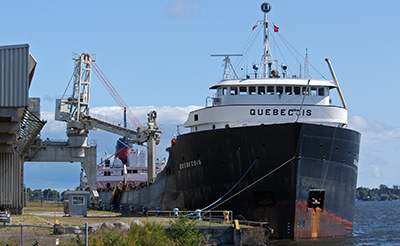
The Quebecois ship moves into the Port of Duluth-Superior, which is one of the ports receiving funding from the MnDOTís Port Development Assistance Program. Photo by David Gonzalez |
Four projects that support freight movement on Minnesota’s waterways received a total of $5 million in grants through MnDOT’s Port Development Assistance Program.
The program will help one project in the Twin Cities metro area and three projects in Greater Minnesota improve the transportation system and support growing industry and business.
The funding helps leverage local and private funding for a total construction program of $8 million.
“One of Minnesota’s strongest assets when it comes to economic development is its infrastructure,” said Patrick Phenow, ports and waterways program manager. “Projects proposed offer us an important opportunity to collaborate with our local partners to help enhance transportation and economic outcomes in Minnesota. The projects selected under this competitive program best demonstrated local government’s willingness to invest in the transportation system and the private sector partners’ commitment to job creation.”
The projects awarded funding are:
- St. Paul Port Authority ($1,818,050) – The project will install a rail spur extension, rehab a connecting rail spur and pave a reinforced loading/unloading pad in the Southport Terminal. The project is a piece of the larger Southport Terminal Intermodal Improvement Project and will ultimately reduce the cost of freight transportation and facilitate more intermodal movements at the site. Total project cost is $2.5 million.
- Duluth Seaway Port Authority ($2,272,562) – The project will provide for additional vessel mooring and storage area at the facility, allow for dredging to full seaway depth and will stabilize existing failing timber and concrete dockage. The project will also help support the recently opened Duluth Intermodal Terminal. Total project cost is $4.4 million.
- Wabasha Port Authority ($454,876) – The project will construct a new barge terminal, which will include dredging of existing access channel and placement of the dredge cut material on the adjacent barge terminal site to raise elevation to create the five- acre terminal pad and access road. The project will significantly increase opportunities for river freight users in the area that must truck to/from the Twin Cities for river access. Total project cost is $625,500.
- Winona Port Authority ($454,512) – The project will install new paved drives, retention ponds and reinforced concrete piping and inlets designed to direct storm water to retention ponds. It will improve conditions by reducing dust and improving the efficiency of truck movements within the property and redirecting surface water more efficiently. Total project cost is $649,550.
Minnesota’s commercial ports located on Lake Superior and the Mississippi River connect businesses to markets across the country and around the world. The state’s Lake Superior ports alone generate $1.3 billion for the state’s economy and support more than 6,200 jobs. Overall, the program has awarded $35 million since it was established in 1994.
For more information about the selected projects and the PDAP program, check out the program’s website. |
 |
|

|
 |
TABLE of CONTENTS
 |
Video showcases Shout Out! Round 2 WIG 2.0 teams, progress |
By Judy Jacobs Winners of the WIG 2.0 Shout Out! Round 2 friendly competition are featured in a new video that showcases 15 winning WIG 2.0 teams from across the state, as featured in Newsline last month.
WIG coaches submitted their teams’ sub-WIGs recognizing completed sub-WIGs as well as sub-WIGs that had reached major milestones. Winners were selected based on sub-WIGs that show innovative ideas as well as having the potential for high impact to customers. The decision to include in-progress sub-WIGs that reached key milestones was based on feedback from the WIG Shout Out! Round 1 competition.
“WIG Shout Out! recognition is a great way to highlight WIG teams working towards advancing equity and improving customer engagement in new and exciting ways,” said Sue Mulvihill, deputy commissioner and chief engineer. “Congratulations to these 15 Shout Out! Round 2 winners.”
“This video gives WIG teams the opportunity to tell their stories and share the successes they have had with their sub-WIGs,” said Chief of Staff Eric Davis. “These inspiring examples illustrate how we all can continuously improve our customer’s experience and earn their continued trust.”
The video is about 18 minutes long. To simplify viewing, here are direct links to specific WIG teams’ experiences:
This video showcases 15 winning WIG 2.0 teams from across the state. Video produced by Nancy Bennett, Joel Wenz and Clay Ebeling |
|
 |
|

|
 |
TABLE of CONTENTS
 |
Shared services program expands to two new areas |
|
By Rich Kemp
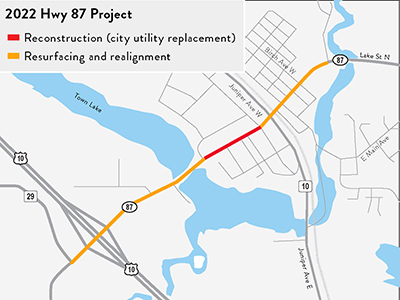
Maps like this one for the Hwy 87 project in District 4 are part of the services the Office of Communications provides to the districts. |
The shared services program has expanded to include public engagement visual communications and signal timing and optimization. The concept of the program is focused on building efficiencies and reducing redundancies so that services can be provided on behalf of the entire organization.
“Shared services is a great opportunity to efficiently use our internal staff to assist the districts,” said Jody Martinson, assistant commissioner for Operations Division. “It may seem like a simple effort, but it pays great dividends.”
Managed by the Office of Communications, the visual communications shared service will provide district staff with assistance on graphic design, website services and social media. The public engagement steering committee met with the districts to prioritize their needs and identified these three areas as high priorities.
“While the Office of Communications has always provided public engagement support, the new public engagement shared services form is designed to give districts a streamlined, trackable way of submitting construction project-related requests for web, graphic design or social media support services,” said Kevin Gutknecht, Office of Communications director. “By looking ahead at future public engagement needs and providing us with more information about those needs up front, we’re able to put more effort into the deliverable and turn the request around more effectively.”
The first step for the district staff is to identify a need and then submit the request form. The service is currently provided to the districts at no cost. The Office of Communications staff will track the resource needs and re-evaluate the process later this year.
The new signal timing and optimization shared service is managed by Michael Fairbanks, Metro Traffic Signal Operations Unit. The goal of this shared service is to provide districts with needed expert signal timing and optimization resources, to more efficiently manage budgets and to ensure consistency in signal timing and maximizing system signal performance throughout the state.
This process applies to MnDOT signal timing projects that are stand-alone signal timing projects or projects associated with a construction project.
“The Metro Signal Operations Unit is excited to offer the signal timing and optimization shared service to the districts,” said Fairbanks. “We are ready and open for requests. Our unit will also make recommendations to help guide the districts’ needs for communications to the Central Traffic Signal Control System or CTSCS.”
Metro Traffic Operations unit will provide districts with this shared service at a minimal cost. The signal timing projects may be completed by Metro Traffic or by a consultant managed by Metro Traffic and funded by the non-SRC consultant budget central fund. The requesting district will compensate Metro Traffic for their time and travel expenses. See the process guidance document for further detail.
Additional implemented shared services include:
- Real estate, managed by Julie Groetsch, Office of Land Management
“The real estate shared service unit has aided each district in some manner, from valuation reports to negotiating with landowners,” said Groetsch. “It has been a pleasure seeing the success of these projects.”
- Signal and lighting design, managed by Mike Gerbensky, Metro Traffic
“Shared services gives us the opportunity to share and discuss ideas about signal and lighting design with others throughout the state, which promotes greater overall understanding of design, construction and maintenance issues,” said Gerbensky. “We are currently accepting shared service requests for FY 2019 (or beyond). We would like requests submitted as early as possible to better understand the workload in order to determine if in-house staff or consultant(s) are needed.”
- Regional Transportation Management Center – Intelligent Transportation Systems, managed by Terry Haukom, RTMC
“Extending the ITS network statewide and bringing some uniformity to processes statewide through the use of ITS Shared Services, has seen a positive effect on documentation as well as maintenance,” said Haukom.
- Signing Design, managed by Josie Tayse, Office of Traffic Safety and Technology
“OTST signing is busy producing shared service signing projects,” said Tayse. “The size and scope vary with each project. We are currently designing a few projects for FY 19 and are accepting signing shared service requests for FY 19 and FY 20 projects.”
Other shared services under development are blowing snow control and geographic information systems.
All shared service guidance documents and request forms are available on the iHub at http://ihub/sharedservices/types.html.
The Operations Division is open to applying the shared services concept in other areas. Send your shared service ideas to Marilyn Jordahl-Larson, shared services program director, at 651-366-4666. |
 |
|

|
 |
TABLE of CONTENTS
 |
Commercial Vehicle Operations reorganizes with a customer focus |
By Sue Roe
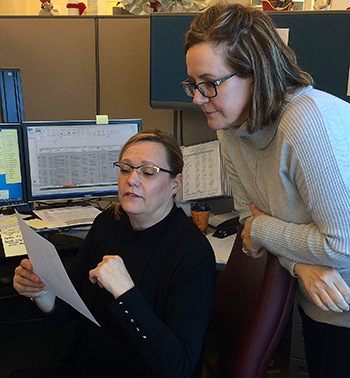
Deb Ledvina, right, Commercial Vehicle Operations director, works with Lori Brown in the credentials and permitting office. The CVO side of the Office of Freight and Commercial Vehicle Operations recently restructured for a more customer focus. Photo by Sue Roe |
The commercial vehicles section of the Office of Freight and Commercial Vehicle Operations reorganized late last year to better serve its customers and improve relationships with customers and partners.
“We knew we could operate more efficiently and effectively,” said Ted Coulianos, deputy CVO director. “We almost look at this as a ‘lean’ effort, where we improved performance by considering ways to reduce inefficiencies and improving our interactions with our customers.”
The reorganization included adding staff to the credentials unit and incorporating a new customer engagement emphasis.
“We talk to the public every day at our front counter,” said Deb Ledvina, CVO section director who led the reorganization efforts. “And we do other work where we interact with customers, such as answering the motor carrier information line, training carriers, providing written and online education materials and conducting safety reviews at motor carrier companies.”
She said an increased focus on customer service meant a push for enforcement staff to also educate customers.
“We’re a highly regulated industry and to put that customer service goal on top of their enforcement responsibilities is a big change,” she said. “But it’s already resulted in efficiencies. We now call customers in advance and tell them when their vehicles are due for their annual inspection and then schedule them well in advance to minimize last-minute delays.”
The commercial vehicles section issued 77,841 oversize/overweight transportation permits last year. Enforcement staff conducted 3,605 safety inspections on special transportation services vehicles that transport the elderly and disabled, and conducted 674 limousine inspections. About 218 audits of motor carrier operations were conducted to ensure compliance with vehicle and driver safety regulations.
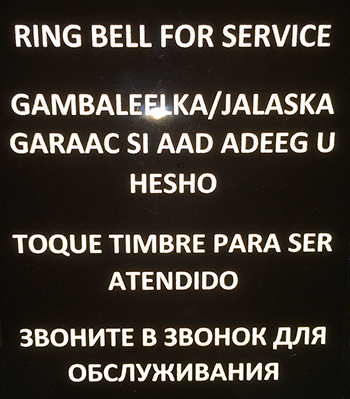
This is the sign in the front lobby of the Commercial Vehicle Operations credentials and permitting office. It offers directions in Somali, Spanish and Russian as those three languages represent a significant portion of the customer base. Photo by Sue Roe |
Signage in the Central Office front lobby was translated into Somali, Spanish and Russian, as they represent a significant portion of the customer base. Educational materials will also be made available in these languages.
Another change was to separate duties of staff who worked with both federal programs, such as compliance audits and hazardous materials regulations, and state programs, such as audits and inspections for limousines and special transportation services.
“Separating federal and state programs will lead to efficiencies with training, performance goals and increasing the quality of work product because employees can concentrate on one program and do it well,” said Ledvina. “Our customers will notice this change because the way we do our work will be more consistent and uniform.”
She said the separation of duties also will improve fiscal accountability since the federal work is reimbursed under a grant from the Federal Motor Carrier Safety Administration.
Supervisors of the different units were reassigned based on their skill sets and business needs. Some supervisors had supervised the same unit for many years and Ledvina wanted to give them a chance to learn something new and give a different perspective to what had been done in the past.
“These reassignments were made after discussion with each supervisor and they had a choice of where they wanted to go,” Ledvina said. “This was an intentional way to get people to think differently and foster innovation while respecting their knowledge and experience. The supervisors were with the sections for a long time, so they knew the basics of each unit and took on their roles without a lot of difficulty.”
The office also worked with the Management Analysis and Development Services, operated out of the Department of Minnesota Management and Budget, to conduct employee interviews to find ways to better operate the office, including booth Central Office and district staff.
Coulianos credited Ledvina, whose previous work at MnDOT included director of the ombudsman office, with championing the restructuring and said it is her vision that is helping the section serve its customers better and prepare for any federal changes that might affect the office.
“Our primary goal was to streamline to make business more efficient. She challenges us to think on that level,” he said. “We aren’t going to keep doing what we’ve always done.”
The office is currently offering five mobility and two SEED student opportunities.
“These kinds of opportunities promote new ways of thinking and brings diversity into our office,” said Ledvina. “Commercial Vehicle Operations may sound like an uninteresting office to work in, but it is a very interesting, diverse and fascinating office.” |
 |
|

|
 |
TABLE of CONTENTS
 |
2018 Construction Summit breaks new ground |
|
By Mary McFarland Brooks
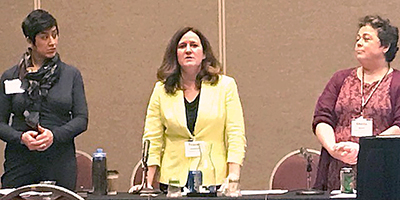
Presenting at 2018 Construction Summit breakout session (from left) Sarah Rudolph, MnDOT; Tracey Jackson, Met Council; and Sheila Scott, Minnesota Deptartment of Administration. Photo by Mary McFarland Brooks |
For the first time in Minnesota, women and minority contractors, along with general contractors, hosted a construction industry conference on Jan. 9-10 to share knowledge and expertise in their field. Held at the Minneapolis Convention Center, the Summit was the brain child of the Association of Women Contractors, who reached out to the Associated General Contractors of Minnesota and the National Association of Minority Contractors to join forces for the future, which was the Summit’s focus.
The Summit targeted professionals in all areas of construction: owners, craft workers and project managers. Breakout sessions focused on:
- Diversity
- Regulatory compliance
- Construction
- Technology
- Leadership development
One of the breakout sessions, Meet the Goal or …!, generated valuable discussion among the Disadvantage Business Enterprise owners attending.
“For those executing state and federal programs for DBE’s, receiving and comprehending their perspective is critical,” said Sarah Rudolph, Office of Civil Rights small business contracting supervisor, who was one of the session’s presenters.
Jim Cownie, Office of Chief Counsel, was part of the Construction Ethics and the Law panel that discussed generations functioning together in the workplace.
“I think it’s a good indication that people are paying close attention to recent scandals and ethical failures,” said Cownie. “Contractors and public agencies recognize the importance of having an ethical construction industry in Minnesota, and in building an ethical culture for their organization.”
The conference featured a networking reception and a two-day trade expo, which included a MnDOT
booth staffed by the Office of Civil Rights. The Summit also featured keynote speakers Walter Bond, former U of M Gopher and professional basketball player, who gave the opening presentation, “Think + Execute = Win,” and FMI principal, Brian Moore, who delivered the keynote presentation on the second day, “Emerging Trends.”
Moore’s presentation focused on technological advances in the workplace, including:
- Work vests that track the whereabouts of the wearers for safety and productivity purposes
- Augmented reality goggles that allow wearers hands-free access to project schematics
- Bluetooth enabled sensors to indicate concrete cures
- Bridges built off-site and installed overnight to avoid traffic disruptions
- 3-D printing of bridges, homes etc., being led by Japan
- Autonomous robotic equipment to work around the clock
- Robot suits -- wearable exoskeletons to increase human strength for lifting and endurance
More than 300 attendees joined the event; plans are in the works for continuing the Summit in 2019. |
 |
|

|
 |
TABLE of CONTENTS
 |
Sexual harassment discussion kicks off lunch-and-learn series on discrimination topics |
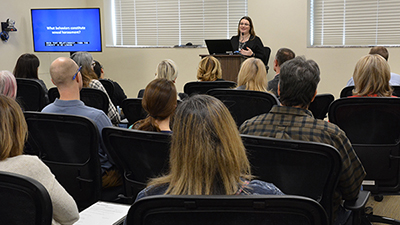
Kimberly Malone, Office of Equity and Diversity, spoke on the subject of sexual harassment during a lunch and learn session Jan. 31. Photo by Rich Kemp |
Tackling the topic of sexual harassment, the Strategic Women Advancing Transportation Employee Resource Group and the Office of Equity and Diversity Jan. 31 kicked off a series of lunch-and-learn sessions on discrimination.
Kimberly Malone, discrimination case manager, Office of Equity and Diversity, presented information on:
- MnDOT and Minnesota Management & Budget’s sexual harassment and discrimination policies
- MnDOT’s various avenues to bring forth concerns of discrimination, including sexual harassment
- MnDOT’s response to concerns/complaints about sexual harassment
Sexual harassment is defined as “unwelcome sexual advances, unwelcome requests for sexual favors, or other unwelcome verbal, written, or physical conduct or communication of a sexual nature.”
Malone said that employees are encouraged to report all incidents of sexual harassment as soon as possible after the incident occurs to:
- Any agency supervisor
- Human Resources office
- Any member of agency management, up to and including the Commissioner
- Office of Equity and Diversity (651-366-4726)
The hour-long presentation was streamed live from a packed conference room in Central Office to employees throughout the state. A videotape of the program will be posted soon on the Employee Resource Group IHUB page at http://ihub/employeeresourcegroup/.
Future lunch-and-learn sessions will focus on skill building to address multiple forms of harassment to assist in setting a work environment that supports workers’ dignity and contributions, and is intolerant of all forms of harassment.
All MnDOT employees are required to annually review and acknowledge the state policy prohibiting sexual harassment. |
 |
|

|
 |
TABLE of CONTENTS
 |
New branded Office templates have arrived |
By Adam Oie

Branded document templates are now available in Microsoft Word and PowerPoint. |
MnDOT employees will notice something new when they launch Microsoft Word and PowerPoint. Branded document templates are now integrated directly with the applications. Forget about hunting down templates on iHub, or worrying if it is the latest version. Simply click the template in the application start screen or by clicking File > New.
This new feature will save time and make it more efficient, but there is another added benefit — these templates have been vetted by a cross-agency team of accessibility coordinators and have best-practices baked in. By using the integrated styles and instructions found in the templates, employees will end up with better documents out of the gate, and will spend less time making them accessibile later.
For information on these new templates, contact Communications.
|
 |
|

|
 |
TABLE of CONTENTS
 |
Learn how to create accessible documents |
|
Minnesota Management and Budget is offering accessibility training for Microsoft Word, Excel and PowerPoint, and Adobe Acrobat Pro.
The training can help employees:
- Conform to state law to protect against legal issues (accessible documents are required by state law – 2010 Minnesota State
Accessibility Standard)
- Increase productivity
Accessible digital documents improve the experience for everyone, from the document creator to the end user.
To register for the classes, call the MMB front desk at 651-201-8000.
For more instruction on creating accessible documents, see the MNIT Office of Accessibility’s electronic document resource library. |
 |
|

|
 |
TABLE of CONTENTS
 |
Scott McBride receives award from NCITE |
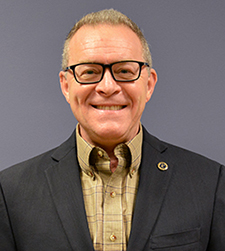
Metro District Engineer Scott McBride. Photo by Rich Kemp |
The North-Central Section of the Institute of Transportation Engineers awarded Scott McBride, Metro District engineer, with their Past Presidents’ Award for Transportation Professional of the Year.
The award is given annually to an individual who has made outstanding contributions to NCITE.
McBride received the award for work he did with the NCITE leadership team and MnDOT leaders to encourage employees to be active in professional organizations in the transportation industry like NCITE.
“Awards like this are very humbling,” said McBride. “It is very important to me personally to have MnDOT employees connect to our private and public sector organizations.” |
 |
|

|
 |
TABLE of CONTENTS
 |
View from a plow: Veteran snowfighter, novice rider take on Jan. 22 storm |
By Sue Roe
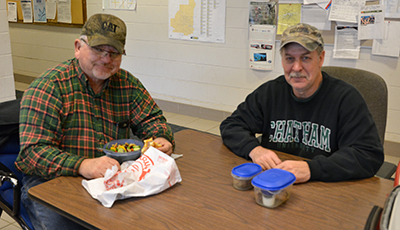
Arnie Huinker, left, and Al Heilman take a lunch break at the Lakeville Truck Station. Huinker drives the tow plow and Heilman drives a snowplow, often in tandem, during winter weather. Photo by Sue Roe |
It started with an email from Rob Hendel, maintenance supervisor at the Lakeville truck station.
Snow was falling fast on Jan. 22 and I considered leaving early to beat the traffic and relax in the comforts of home during the storm that was closing in. Instead, Hendel invited me to come to Lakeville and ride in a snowplow.
We talked earlier in the winter season about how riding in a snowplow would be a great opportunity to see snowplows and drivers in action.
"Wait until a big snow," he said.
This was my chance. How could I resist?
Shortly after 1 p.m., I was riding shotgun with Al Heilman, 11-year MnDOT veteran. We were “gang plowing” and in the third truck driving northbound on Interstate 35E. The road was not just snow covered; it was inches deep in snow. Heilman had been plowing the 22-mile route since his day began at 7 a.m. His route is from Lakeville north to just beyond Cliff Road where the crew plows a bit more to overlap with the Mendota Heights crew.
Each time the three plows plowed the route, it was like it was their first pass of the day. Heavy, wet snow was accumulating fast. It rolled and churned off the front blade while the wing blade pushed it off the right shoulder.
As we traveled 20 miles per hour, Heilman expertly knew how close he could get to a guardrail or when a concrete abutment was ahead, making him veer slightly. He paid attention to the traffic around him and the plow in front. He checked the Automated Vehicle Location screen, which showed he should spread 100 to 150 pounds of salt per lane mile.
"If we wouldn’t have put down a little material earlier in the day, we’d be getting some icing right now and compaction,” he said. “We don’t want to put too much down, because it’s just going to get snowed on and pushed away. This will help some drivers now."
As we drove, Heilman also listened to the radio chatter from the two plow drivers in front, the Regional Transportation Management Center and the other Lakeville team of four plow drivers who were plowing I-35W.
At times, the front two plows kicked up so much snow that we could barely see their flashing lights. In the mirror I could see we were kicking up a snow cloud of our own, forcing wiser drivers to slow down and fall back.
But sometimes, as we drove mere feet from the plow staggered to the left and in front of us, motorists tried to drive beside us.
"What’s he trying to do?" I asked, more in judgment of the driver’s unsafe behavior than as a question.
“You see a lot of that out here,” Heilman calmly said.
Heilman honked and the driver backed off. Up and down the route, we'd seen other drivers attempt to get around the three snowplows. When the motorists realized that gang plowing meant that two lanes and each shoulder were taken up by these 50,000-pound snow machines, they had no choice but to slow down and follow behind.
As we plowed bridges, Heilman slowed down, carefully avoiding blowing snow onto the highway below. The new snowplow, with only 6,000 miles on it, slowly ground through the accumulating snow. At one point, our truck fell behind the other two plows because it was also plowing what the plow in front had pushed off the road. I looked out my side window, just inches from the snow rolling off the front blade.
"This is as fast as it can go," he said, shifting into fourth gear.
I asked Heilman if he had ever gotten stuck.
“Not yet,” he said with a smile.
He estimated there were already more than six inches on the ground. Weather predictions said one to two inches were falling per hour and would keep up for a few more hours.
At one point, the three plows pulled onto an exit ramp so the drivers could clear off the ice from the windshields and discuss the strategy of whether to plow the ramps so people don’t get stuck or to continue on the main route. They decided that Bill Lane in the front plow would continue on the main route and Heilman and Dan Hycke, in the middle plow, would take on the ramps.
At about 4:30 p.m., Heilman said it was time to go back to the shop to refuel and get more salt because a full load makes the truck heavier. There was still time to do the route a few more times before his 12-hour shift ended at 7 p.m. He said he would squeeze in a dinner break with the other two gang-plowers back at the truck station.
I asked Heilman how this storm, that ended up dropping 15 inches of snow, rated on a scale of 1 to 10.
“It’s a seven or eight,” he said. “It’s a good one.”
In this video Al Heilman, snowplow operator from the Lakeville truck station, talks with Sue Roe about the roads and his efforts to keep them clear. Video by Sue Roe |
|
 |
|

|
 |
TABLE of CONTENTS
 |
New champion takes over for WIG 2.0 Internal Customer Engagement Focus Area |
By Janet Cherney, assistant division director, Corporate Services
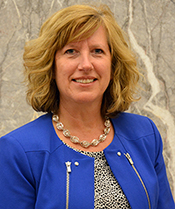
Janet Cherney is the new champion for WIG 2.0 Internal Customer Engagement Focus Area. Photo by Rich Kemp |
When Assistant Commissioner, Sue Stein asked me to step into her role as champion for the WIG 2.0 internal customer engagement focus area, I was very excited! In my previous role as Metro District Administrative Manager, I had the privilege of working with a number of wonderful sub-WIG teams who worked tirelessly to improve the customer experience for their internal customers (see the Shout-Out Round 2 video, also featured in this edition).
Since joining the Corporate Services Division and the Senior Leadership Team, I have continued to witness the incredible energy with which MnDOT employees work to improve their customer engagement and it is very inspiring.
Thinking of our coworkers as our customers has been a culture shift for MnDOT and I believe it is the right thing to do. We have all been in a situation at one time or another during our careers where we felt the impact of a coworker’s workflow – either in a good way or sometimes in a not-so-good way.
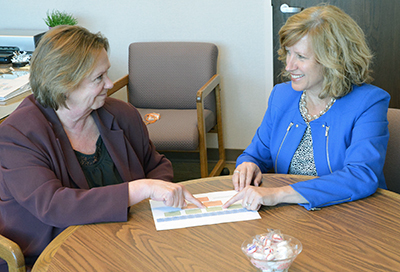
Janet Cherney (on right), assistant division director, Corporate Services, and champion for the WIG 2.0 internal customer engagement focus, reviews the WIG 2.0 framework with Sue Stein, assistant commissioner, Corporate Services Division. Photo by Rich Kemp |
Our goal with WIG 2.0 is to make all those customer impacts and experiences good. This doesn’t necessarily mean we can accommodate every request, but we can involve our customers and consider their impacts so they have better experiences and feel heard each and every time we interact.
The WIG gives us a great opportunity to pull something out of our everyday work that we want to make better or more efficient and give it a special focus. As we near the finish line of WIG 2.0, it’s critical to think about how we can most effectively put all that amazing work back into our day-to-day whirlwind so we all continue to benefit from these efforts for many years to come. We have a simple worksheet that will help you and your team walk through how to ensure you have everything in place to put your sub-WIG back into the whirlwind.
I want to thank Sue Stein for her champion role in WIG 2.0 - she has been an incredible advocate of internal customer engagement throughout her career. |
 |
|
| |
|



